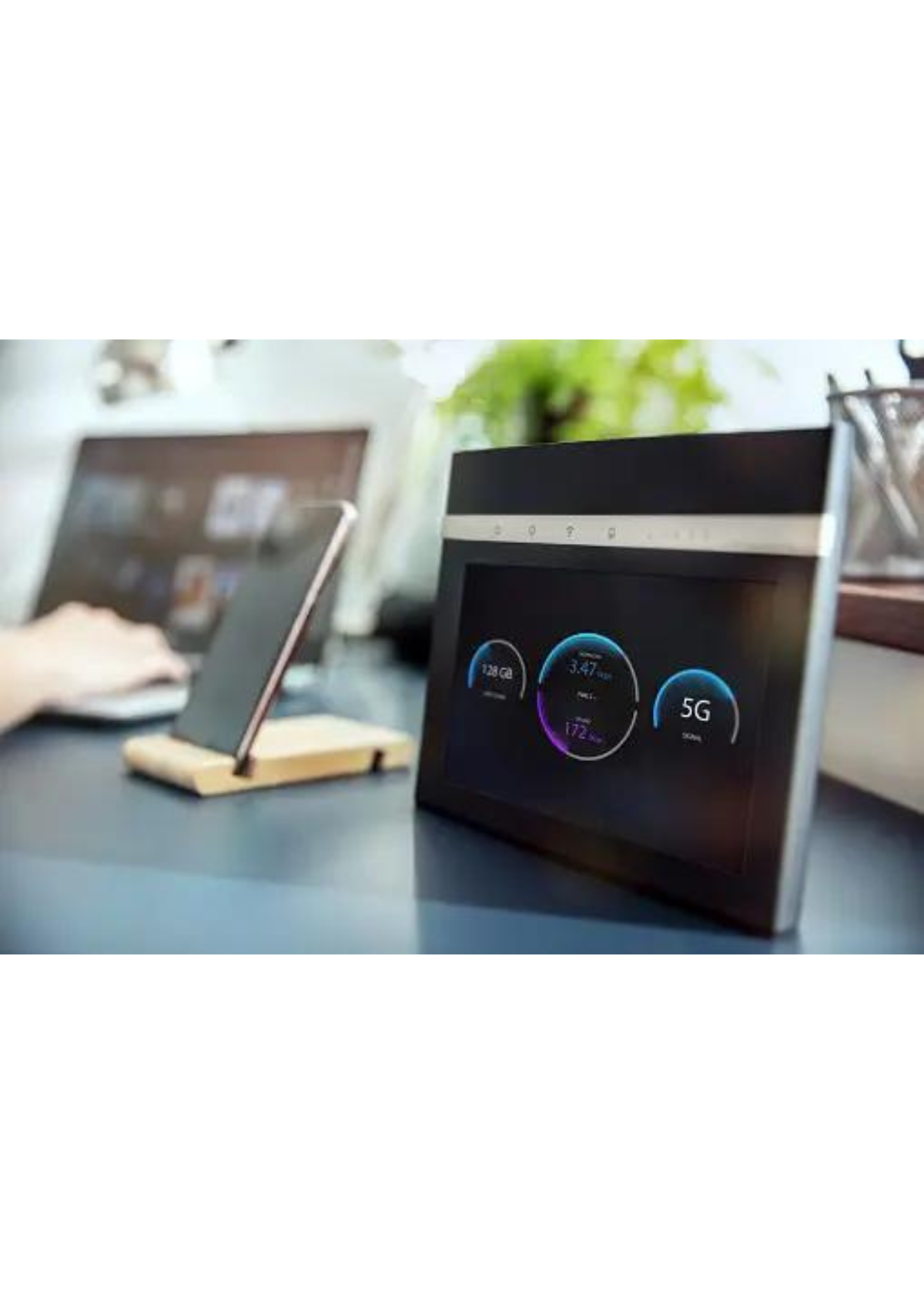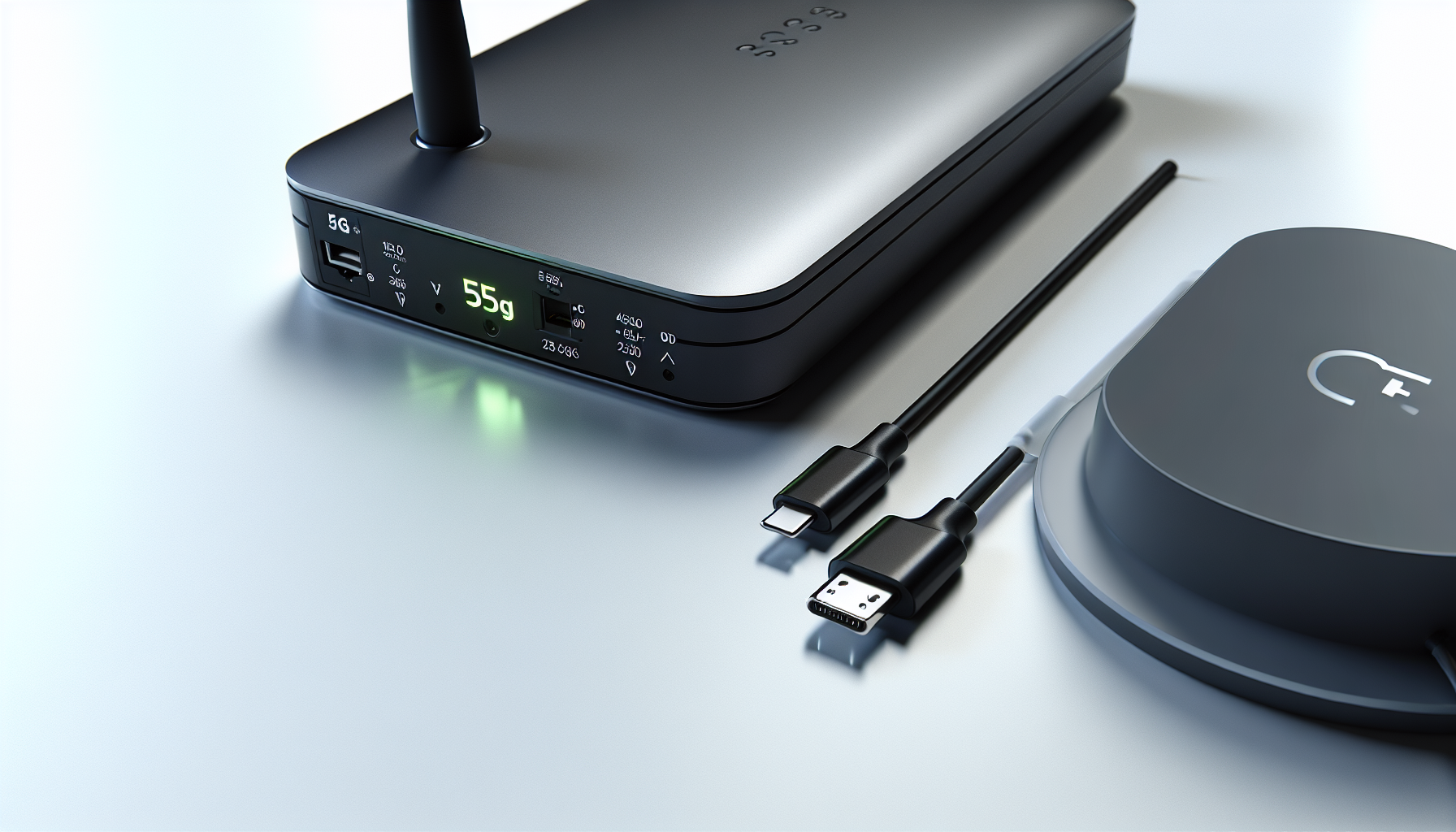Effortless Internet on the Go: Exploring the Portability of 5G Routers
This blog post assesses the feasibility of 5G routers for mobile internet.

Consider a 5G router for on-the-go internet needs. Discover how the portability of 5G routers holds up under real-world conditions. We evaluate their compact design, adaptability to network coverages, and overall practicality for personal and professional use. Expect an honest look at the benefits and limitations of these devices, all without the push to buy. Dive in to understand if a portable 5G router suits your mobile connectivity demands.
Key Takeaways
- Portable 5G routers offer high-speed internet, compact design, and the ability to connect multiple devices, ensuring seamless connectivity for individuals and groups.
- The performance of 5G routers greatly depends on regional 5G network coverage, which varies considerably between urban and rural areas, affecting the reliability of the connection.
- Choosing the right 5G router involves considering compatibility with network carriers and frequency bands and evaluating data plans, pricing, and alternatives like 4G LTE hotspots and smartphone tethering.
The Advantages of Portable 5G Routers

Imagine having the ability to seamlessly stream your favorite films while camping or conduct a crucial business meeting from a remote beach. Portable routers make this achievable by providing high-speed internet access comparable to traditional broadband in a compact and lightweight design. They are ideal companions for digital nomads, telecommuters, and teams needing constant connectivity.
The potential of 5G mobile hotspots extends beyond individual use as these devices can simultaneously support multiple devices, offering a shared high-speed connection for groups of people. Whether traveling with family or working together on an off-site project, 5G routers ensure everyone stays connected regardless of location.
High-Speed Internet Access
When discussing 5G, its speed is the primary aspect that stands out. This advanced technology surpasses previous versions, such as 4G LTE, offering download speeds of up to 1,000 Mbps in certain areas. As a result, tasks like downloading large files or streaming high-quality videos can be done quickly with no interruptions.
The critical factor behind this remarkable performance lies in the exceptionally low latency of 5G networks. On average, these networks have an impressive latency rate of around 32ms, significantly contributing to creating a stable and highly responsive online experience. For activities such as competitive gaming, where quick reaction times are crucial for success, having access to reliable and speedy connections becomes even more critical. 5G has emerged as a stronger alternative for gamers than traditional fiber options due to comparable stability and speed levels.
In conclusion, factors ranging from closing business deals smoothly to achieving victory in online games heavily depend on fast connection capabilities by utilizing routers equipped with state-of-the-art data transfer technologies designed to deliver optimal experiences. This makes it clear how essential it is to implement fifth-generation (5) wireless protocols to enjoy the fastest online connectivity today’s digital world demands.
Compact Design and Portability

5G routers offer more than just fast internet access. They also prioritize convenience and portability. Take the Nighthawk M6, for instance. Measuring 0.85 inches in height, 4.14 inches in width and depth, and weighing only 0.55 lbs with its battery, it’s small enough to fit into your pocket.
These devices also come equipped with travel-friendly features such as support for multiple SIM cards and the ability to be powered through portable banks. You can easily switch between network providers or ensure your device stays charged during long trips.
Whether globe-trotting or working from a coffee shop down the street, a reliable 5G router ensures high-speed internet access with unlimited data wherever you go.
Support for Multiple Devices
One of the prominent features that sets a 5G router apart is its ability to connect multiple devices. Whether you are on the go with a group or working remotely, everyone can link their gadgets to one 5G router for fast and shared internet access.
To make the most out of your 5G router, ensuring all connected devices support Wi-Fi options like Wi-Fi-6 is crucial. Most routers have user-friendly apps facilitating easy placement and settings adjustments for optimal connection across various gadgets.
The number of simultaneous connections supported by a particular model may vary. Advanced versions cater to more linked devices at once. Whether you have a large team or just looking after your family’s connectivity needs, a reliable and efficient solution would be connecting them all through one powerful 5G router.
Limitations of 5G Router Portability: Coverage and Network Availability
While the advantages of 5G routers are impressive, they have some limitations. One major constraint is regional 5G network coverage. The availability of 5G routers is highly contingent on the coverage of the 5G network in your location. This means that while you may have a state-of-the-art 5G router, its performance will be restricted in areas with limited 5G coverage.
Moreover, coverage limitations and varying network availability can significantly restrict the use of 5G routers in rural and remote areas worldwide. Before investing in a 5G hotspot, it’s advisable to check the coverage in your intended usage areas using tools like the Ookla 5G Map or carrier-specific maps. It’s also recommended to choose a 5G hotspot plan from a provider with a fast, extensive, and accessible network for seamless connectivity and service.
Regional Differences in 5G Coverage
The level of 5G coverage varies depending on the region and is influenced by factors such as economic development and urbanization. Typically, countries with a high Gross National Income (GNI) per capita and significant levels of urbanization have better 5G coverage. Markets like South Korea and the USA are leading in 5G Coverage Experience due to their early adoption and extensive low-frequency band deployment.
In areas with a large population residing in cities (for instance, Singapore or Hong Kong), easier infrastructure rollout can be achieved, thus improving overall network coverage experience thanks to feasibility facilitated by concentrated demographics living within proximity. Suppose you plan on utilizing your 5G router at different locations worldwide. In that case, it’s important to remember these regional differences as they can significantly impact your access to reliable networks.
Impact on Rural and Remote Areas
While 5G has brought numerous advantages to urban regions, its implementation in rural and remote areas presents unique challenges. Lower population density is one factor that contributes to the difficulties faced by service providers in expanding their networks into these sparsely populated locations. The vast expanse of land makes high-frequency 5G deployment less profitable for companies, making them hesitant about investing resources.
There are potential solutions available that offer hope for improved coverage in rural areas. For instance, long-range frequencies with low bandwidth can cover more considerable distances while requiring fewer cell towers than other options, making it more practical for use in rural settings. Satellite technology provides backhaul connections and supports multi-orbit and multi-transport configurations necessary for establishing efficient 5G networks, even in remote places.
Despite the obstacles posed by limited infrastructure and profit incentives, multiple innovative solutions are being developed explicitly to bridge the digital divide between urban centers and inaccessible or underdeveloped areas. Steps like implementing new frequency ranges or utilizing satellites as transmission mediums hold promise toward bringing equitable access to advanced network services, even in remote and rural sections.
Choosing the Right 5G Router: Compatibility and Carrier Considerations
Selecting a 5G router is not as easy as selecting one with an attractive appearance or lower cost. Two key factors are its compatibility with different frequency bands and network carriers. These elements are vital in ensuring the broadest coverage and best possible performance.
To make these considerations clearer, let’s break them down further. First, it’s essential to ensure that your chosen 5G router is compatible with various frequency bands used by different networks. Depending on your location, this will allow for a wider coverage range and better connectivity options.
Frequency Band Compatibility
The compatibility of a 5G router with different frequency bands is crucial for its optimal performance. Various carriers may use different spectra when deploying their 5G networks. To function efficiently on these networks, routers must support the specific 5G NR (New Radio) frequency bands defined by the 3GPP.
To avoid any connectivity problems, it’s essential to ensure that your chosen 5G router supports the frequency bands used by your preferred carrier(s). You can verify this information in the router’s specifications. As new frequencies may be introduced in future advancements of 5G technology, it’s also essential for routers to have compatibility with potential expansions.
For maximum flexibility and usability both domestically and internationally, it is recommended to choose a security setting that allows for wide-ranging compatibility between various carriers’ network spectrums - including but not limited to 600 MHz.
2.6 GHz,
3.GHz.
4 GHz.
28 GHZ.
39 Ghz.,and even up to 50GHz.
Carrier Compatibility
Verifying carrier compatibility is vital when considering a 5G router. This involves checking if the device will function properly with the user’s network carrier. It should be noted that even unlocked devices may not work on other networks if they do not support a specific carrier’s frequencies or have carrier-specific antennas.
For instance, popular carriers like AT&T and T-Mobile are compatible with models such as Nighthawk M6 (MR6150), M1 (MR1100), and M5 (MR5200). Confirming your chosen network provider before selecting a particular 5G router for maximum effectiveness is advisable.
Powering Your Portable 5G Router: Battery Life and Charging Options

Aside from coverage and compatibility, another vital factor to consider when using a 5G router is its power source. The battery life and charging options of your 5G router are crucial in ensuring it can sustain your connectivity requirements.
Now, we will examine these considerations closely for better understanding.
Improved Battery Life
We all know how frustrating it can be to have our devices run out of power when we need them the most. This is why researchers are investigating innovative solutions to resolve battery draining issues in 5G devices, such as alternate routing models that can reduce battery draining.
Charging practices can also impact battery life. Here are some tips to consider.
- Use chargers that provide patient charging types to increase battery life without causing damage.
- Control the temperature during the charging process, as continuous charging at high temperatures can reduce battery efficiency.
- Explore innovations like ultra-thin vapor chambers and fused surge protection in batteries to improve battery life and ensure safer charging experiences.
Charging Options
Multiple charging choices for 5G routers give users various options. Many portable 5G routers have USB-C charging support, allowing fast and efficiently accessible charging. Specific models can be charged using the standard AC adapter for extended use in a single location.
For individuals who frequently travel or have limited access to outlets, power banks are an alternative way to charge their 5G router on the go. These portable battery packs provide additional sources of power when traditional outlets aren’t available. Some 5G routers offer interchangeable batteries that allow you to swap out depleted ones while they recharge. The wireless feature enables some devices to be equipped with wireless charging capabilities so your power bank doesn’t need cords while providing another convenient option.
Maintaining seamless connectivity at home or on work trips has been made simple by providing several ways to ensure one’s modernized Wi-Fi device powers up smoothly wherever it may be required, all thanks to these superiorly designed operations. Multiple methods exist to ensure constant availability and efficiency levels regarding powering needs wherever necessary during times away from customary utilization areas such as homes/workspaces/road trips, etc.
Data Plans and Pricing: What to Consider When Using a Portable 5G Router

To own a 5G router, securing a suitable data plan is essential for accessing the internet. Providers offer different options for data plans specifically designed for 5G hotspots, so it’s necessary to compare and choose one that best fits your needs. From budget-friendly choices like T-Mobile’s $10/month plan with 2GB of data to more robust offerings like Verizon’s $60/month plan with 100GB and AT&T’s $55/month option with 50 GB.
Now let us Explore these factors when considering which provider and their corresponding data plans would be most beneficial.
Evaluating Data Plans
When analyzing data plans, it is essential to consider several key elements: cost, data allowance, network coverage, and the accompanying map of said coverage area. Important are any extra fees that may be applicable and potential perks like free access to streaming services.
For example, prepaid plans tend to have lower initial costs, while monthly options typically come with higher amounts of available data for use.
The pricing structure for 5G WiFi services can vary based on a variety of factors, including infrastructure expenses, deployment costs associated with bringing these technologies online in new areas or regions where they were not previously present before market competition also enters the equation along with consumer demand resulting from their corresponding needs and usage patterns. In light of this information, making an informed decision about which plan best suits one’s budget and requirements takes on added importance when evaluating various offerings.
Budgeting for Router Cost
The price of a 5G router is an essential factor to consider when upgrading devices. It requires an initial investment, so proper budgeting is necessary. Portable 5G routers have varying prices, with the high-end NETGEAR Nighthawk M6 Pro model costing up to $999.99.
As the technology evolves and competitive forces drive down costs, it is predicted that 5G WiFi will become more affordable over time. Alongside the upfront cost for a router, it’s crucial to consider long-term expenses such as data plans and device capabilities in your decision-making process.
Alternatives to Portable 5G Routers

While 5G routers provide impressive benefits, they are not the sole solution for portable internet access. Various alternatives are available, such as mobile hotspots with 4G LTE connectivity, mobile wifi devices, smartphone tethering options, and public wi-fi access points that offer different forms of connection to cater to individual needs.
4G LTE Mobile Hotspots
For individuals residing in regions where 5G service is not yet accessible, mobile hotspots using 4G LTE technology are a reliable option for internet access. These gadgets have added features such as TS9 external antenna ports to enhance signal strength, and some even allow for switching SIM cards (including local ones), which are helpful for frequent provider changes.
As a result, a high-speed internet connection can still be achieved while on the go without relying on 5G coverage.
Smartphone Tethering
Tethering your smartphone is a handy alternative to using portable 5G routers. This method allows you to utilize the internet connection from your phone to provide access to other devices. It’s important to note that this option usually supports fewer connections at once and may result in quickly draining the battery.
Although smartphone tethering can be a convenient backup solution, it might not be suitable for heavy or prolonged usage due to its limitations on simultaneous device connections and potential impact on battery life.
Public Wi-Fi Access Points
Secure internet access can be obtained through public Wi-Fi hotspots in cafes and coworking spaces. These spots are especially beneficial for businesses that have a mobile presence or individuals who require an online connection while traveling or in areas where they do not have access to the internet.
Frequently Asked Questions
Where is the best place to put a 5G router?
For the strongest signal and coverage, it is recommended to position your 5G router in an unobstructed area near the middle of your home. This can include placing it on a shelf, upper floor, or next to a window. Avoid putting the router near walls or floors, as this may weaken its ability to provide optimal signal strength. Keeping these factors in mind will help ensure reliable connectivity throughout your residence.
Do 5G routers have Ethernet ports?
Ethernet ports are available on 5G routers and can be utilized to establish a direct, fast connection between the router and other devices. This allows for a speedy Ethernet connection without losing essential information or functionality.
Does a 5G router work on a 4G network?
A 5G router will work on a 4G network if you have a good signal.
What are the main advantages of portable 5G routers?
Compact and efficient, portable 5G routers provide fast internet access for various devices while on the move. With its compact design, this option offers convenient support for multiple devices without compromising speed or quality of access to the internet.
What are the limitations of 5G router portability?
The 5G router portability limitations mainly stem from regional 5G network coverage and availability. These factors can impact the portability and usability of the router.
Conclusion
In today’s highly interconnected world, constantly connecting to the internet is essential. The emergence of portable 5G routers has provided a powerful solution for high-speed and flexible access across multiple devices. Although they offer benefits such as fast speed, compact size, and support for numerous gadgets, their limitations include network availability and coverage.
With careful consideration of factors like frequency band compatibility with your carrier provider, battery life duration, and charging options available, you can maximize the potential of these impressive devices. Especially for digital nomads or remote workers who value uninterrupted connectivity, the realm of possibilities offered by 5G routers should be embraced. Other alternatives exist, such as using 4GLTE mobile hotspots, tethering through smartphones, or accessing public Wi-Fi points, but none are comparable in convenience, mobility, and versatility. So take advantage of this cutting-edge technology and explore the future of fast internet accessibility through 5Grouters.
